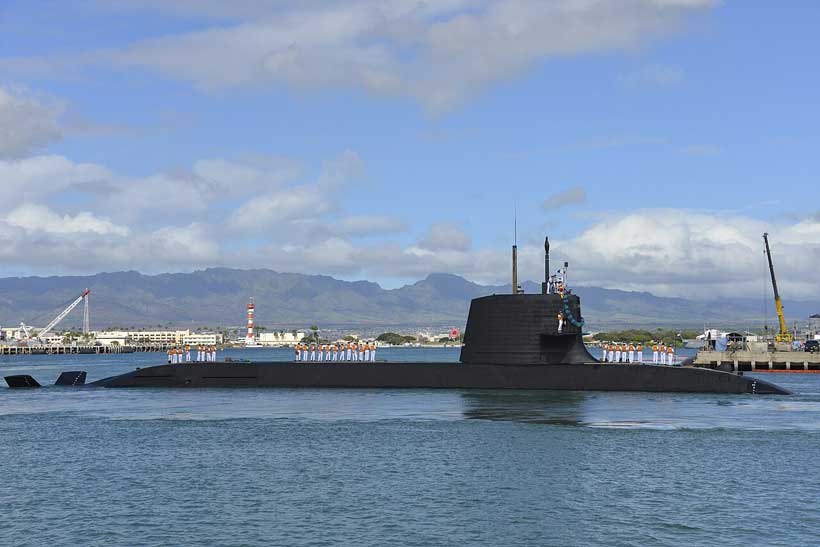Amidst stagnation and uncertainty over AUKUS’ Pillar II time, Australia’s undersea naval capabilities are increasingly aging and prone to being exposed by adversaries such as China and Russia. With an increasingly aging submarine fleet, Canberra drastically needed alternatives through the AUKUS trilateral alliance.
Australia, which relies on its maritime capabilities, needs a major modernization if AUKUS were to fail and leave its navy exposed. Outside of the U.S. and the UK, Australia maintains strong Indo-Pacific relations with Japan, the latter of which is conducting its own remilitarization and modernization of its forces.
Nearly signing a concrete submarine modernization program with Tokyo, Canberra has a potential alternative option in the modernization of its navy with the Japanese Maritime Self-Defense Force (JMSDF). Still, various factors will need to be calculated, assessed, and discussed in the Australian defense sector if any divergence from AUKUS were to take place.
The Original Japanese Alternative
In the spring of 2016, Japan became one of the top bidders for Australia’s submarine modernization. A sure guarantee, the Australian Prime Minister Malcom Turnbull went with France—shocking the Japanese government, to the point where Tokyo saw the act as a betrayal.
One of the reasons why Tokyo lost its bid to Canberra was due to a change in government. Whereas the former Japanese Prime Minister, Shinzo Abe, enjoyed strong relations with his former counterpart, Malcolm Turnbull, the latter’s successor only saw Japan as a bidder instead of a true finalist.
Secondly, the Japanese defense industry faces a myriad of bureaucratic hurdles along with hesitancy over selling the Soryu-class submarines to Australia. Tokyo has struggled with large-scale exports, which hinder the true growth of its defense industry. Lastly, less pushback from the United States led to Australia being firmly set on the French-made Barracuda-class submarines.
Ironically, France itself would be upended by the United States in a backdoor arrangement with Australia that took place at the last minute, causing an international rift among all parties due to Canberra’s breach of conflict of interest with Paris. Fortunately, calmer heads prevailed, mitigating tensions through high-level diplomacy among the various allies.
AUKUS’ Stagnation
Initially showing promising results after the consolidation of Pillar I, AUKUS’ Pillar II took off in a tumultuous direction. With Australia needing AUKUS submarines for deterrence amidst brewing threats, the current timeline for nuclear-powered submarines remains in question.
Currently, the United States is having a shipbuilding and submarine production crisis, which is making future naval exports in a state of purgatory for national readiness. As of today, Washington produces 1.3 Virginia-class submarines per year, which is far below the 2.3 benchmark.
Along with American naval stagnation are rising tensions in the Indo-Pacific that Washington, like Canberra, faces. With tensions rising in the Taiwan Strait, South China Sea, and Korean Peninsula, American naval force projection will be needed at full strength, which could negatively affect future exports of stocks deemed ‘essential,’ as seen during missile strikes on the Houthis and air defense exports to Ukraine.
Australia’s Existential Naval Crisis
Australia is currently in a race against time to upgrade the Collins-class, which was originally due to be retired in 2026, as the aging diesel-electric subs cannot compete with nuclear-powered submarines that adversaries such as China and Russia utilize. The gaps in capabilities could expose the Royal Australian Navy to a rout in submarine warfare if Canberra were to be caught off guard.
Alongside awaiting American production, the UK is also facing hurdles in delivering the final two Astute-class submarines. With Britain’s PWR3 reactor facing critical issues powering the Dreadnoughts, the UK’s own stagnant readiness could negatively affect Australia and AUKUS as a whole.
Furthermore, according to America’s subcommittee on AUKUS, any U.S. president is required to report to Congress 270 days/9 months ahead of time on any transfer or export of a Virginia-class submarine and provide evidence that it will not affect American naval readiness.
The Royal Australian Navy will require three of the five contracted Virginia-class submarines to maintain readiness and deterrence, which will also be a challenge for the U.S. defense industry. Not only does the United States need to phase out older submarines, but fleet production is also 36% behind schedule, affecting Washington and Canberra’s joint readiness.
Could Canberra Reproach Tokyo for Submarines?
Amidst uncertainty in AUKUS’ projection, Canberra could potentially look at other alternatives or reassess the original deal with Tokyo. Nonetheless, Australia will need to consider key factors before making an uncertain decision, as it has in the past.
American indecisiveness in the Indo-Pacific could leave regional countries in a bind, where they would need to come together in mutual partnerships or consider a major deterrence strategy. A wind of change is occurring with South Korea and Japan, and Australia, likewise, could pursue growing defense with the latter.
Though Australia could easily adapt to the Japanese Soryu-class, as the government maintains close procurement with Tokyo, this particular type of submarine lacks the strategic capabilities of the Virginia-class and Dreadnoughts. Australia may need to cover more maritime space amidst Chinese and Russian naval provocations, and to deter Beijing’s and Moscow’s growing axis, Canberra would need to stick with AUKUS.
Despite setbacks, Australia, the UK, and the U.S. continue to reaffirm commitments, which makes it unlikely for now that Canberra will pursue a fail-safe alternative with Tokyo. Nevertheless, Canberra must prepare for bureaucratic and unstable political gridlock from both London and Washington, which could affect future production and collaboration in AUKUS.

